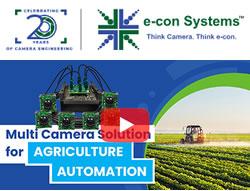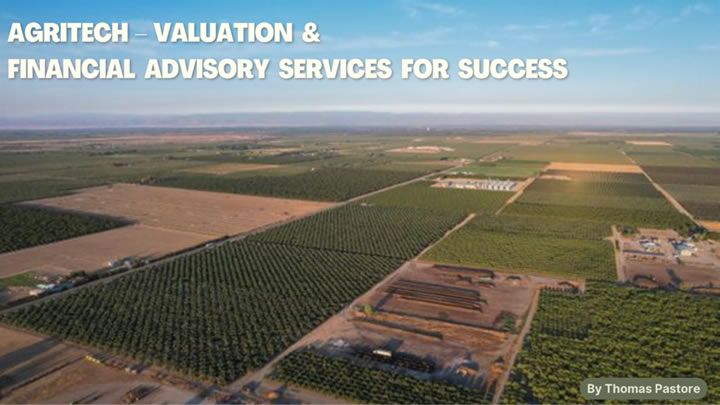This paradigm shift from traditional farming presents many opportunities. However, agriculture, conventional or technology-driven, is fraught with unique risks not present in many other businesses.
Thomas Pastore, ASA, CFA, CMA, MBA | CEO & Co-Founder | Sanli Pastore & Hill, Inc.
A new frontier in business holds many wonderful prospects to feed a growing world population and assist with climate change solutions. This paradigm shift from traditional farming presents many opportunities. However, agriculture, conventional or technology-driven, is fraught with unique risks not present in many other businesses. These include:
- Unfavorable weather conditions
- Pestilence
- Changing soil conditions
- Government regulations/wildlife protection
- Commodity price competition, national and international
- Invasive animals and vegetation
One of the main roles of science and technology is to mitigate and/or avoid these occurrences. Agritech is part and parcel of this role, providing the promise of increased output, lower cost production, and carbon-free results by employing:
- Precision planting

- Bioengineering/seed technology
- Advanced soil management
- Carbon reducing sustainable practices, e.g., no-till farming, cover crops, and crop rotation
- Autonomous farming: robots, AI, auto-steer technology
Translating agritech ventures into profitable businesses can be greatly bolstered by financial advisory services. For agritech companies in various development stages, i.e, from start-up ventures to mature businesses, the financial advisory firm can provide:
- Projected income statements, cash flows and balance sheets
- Scenario and stress testing liquidity and solvency analyses
- Quality of Earnings ("QOE") studies for companies courting buyers
- Fairness opinions for mergers and acquisitions
- Valuation of intellectual property ("IP") and employee stock options
Projections - Avoid Reliance on Hockey Stick Approach
Oftentimes, start up and emerging growth companies will include very optimistic high revenue and cash flow projections in their business plans. In many cases there will be very little or no support for these projections. Optimism is the positive trait of entrepreneurs and is a foundation for success. However, sole inclusion of overly rosy projections, aka, “a hockey stick” in a business plan can taint potential investors’ view of its usefulness. A financial advisory firm can be of great assistance in developing projections. The firm can create a 10 to 15 page presentation providing supporting metrics, graphs, and visual displays for forecasts including:
- C – level executives’ backgrounds and successful track records experience
- Strong and protected company IP
- Product/services' strengths versus competitors
- Industry forecast supports for revenue growth and profit margins
- Demographic trends
- Economic factors
- The company’s market share capture for each projected year
Projected revenues, profits, and cash flows based on the above significantly enhance credibility for the reader audience.
Scenarios and Stress Tests – Reality and Contingency Plans
The financial advisory firm will develop robust confidence-building projections which include high, most likely, and low scenarios. These scenarios will contain a table showing respective scenario revenue volume and pricing, profit margins, market share capture, and any required additional investment rounds. The executive summary at the beginning of the presentation highlights the conditions resulting in each of these three scenarios.
Stress tests illustrate various circumstances in which a company may experience liquidity and solvency challenges. Reduced sales volume, rising costs, strikes, lawsuits, and increasing debt are some of the situations causing financial strain. The financial advisor will work with management to identify particular situations for the subject company and incorporate these into a downturn financial model showing the inflection points at which perilous financial conditions arise. This provides a roadmap for management to create contingency plans to deal with and overcome negative events.

Quality of Earnings (“QOE”) – Historical Accounting Profits v. Going Forward Cash Flows
In the world of mergers and acquisitions, the QOE report helps the buyer and seller understand key company operating metrics, such as QOE ratios, revenues, gross margins, cash flow, adjusted EBITDA, and working capital. It bridges the knowledge gap making both buyer and seller comfortable completing the transaction.
QOE analyses are a deep dive beyond financial statements and include:
- QE Ratio: Net Cash Flow from Operations divided by Net Income
- Quantify quality income and compare to non-cash accounting profits arising from policy changes, foreign exchange fluctuations, allowance and reserve estimate changes, and depreciation estimates
Ratio > 1: higher quality earnings; ratio < 1: lower quality earnings - Additional Key Ratios: quick ratio; accounts receivable and inventory turnover; accounts payable days outstanding; sustainable profit margin; employee turnover
- Revenue patterns and growth, such as anomalies, seasonality, customer concentration, and product concentration
- Expense Adjustments: 1) additional recurring costs after the transaction; and 2) expenses not required after the transaction, such as duplicate overhead for consolidated operations or above-market salaries
- Working capital requirements going forward, account receivables, inventory, reserves, and liability recognition
- Identify and analyze potential indebtedness not on balance sheet which may reduce the purchase price, e.g., fixed asset purchase commitments, litigation matters, and income and sales audits
Fairness Opinions – Testing Deal Terms
A company’s board of directors are subject to the business judgment rule. In the context of mergers and acquisitions (“M&A”), this means that the board must either: (1) possess the knowledge and experience to ascertain whether the proposed business transaction is fair from a financial point of view, or (2) lacking such knowledge and experience (most always the case), rely on an outside independent financial advisor to make this determination presented in the form of a fairness opinion letter and supporting pitch deck.
In rendering a fairness opinion, the financial advisor will conduct due diligence procedures including:
- Extensive interviews with target [I] company’s executives
- Independent research on target company’s operations
- Detailed financial analyses of target’s historical and projected financial statements
- Scenario and stress tests on target’s projected financial statements
- Reviewing all drafts of the purchase acquisition agreement
- Industry, economic, and competition analyses
- Valuation analyses of target usually employing discounted cash flow and guideline (comparable) company M&A transactions methods
If the procedures find that the proposed transaction is fair from a financial point of view, then the financial advisory firm will issue a fairness opinion letter together with a pitch deck which highlights the findings of each of the above procedures. The letter and deck are sent to the board of directors. The financial advisor project manager will make a presentation to the board and field all their questions about the fairness opinion process and the business transaction at hand.
Valuations of IP and Stock Options – Key Assets and Employee Incentives
If a company possesses key know-how, technology and/or patents, it may consider additional monetization through a valuation of IP which can be presented to existing and potential investors as support in raising further investment rounds. The selected financial advisory firm’s professionals should possess the valuation credentials and industry experience to fully support the concluded appraisal opinions. The Accredited Senior Appraiser, business valuation discipline, from the American Society of Appraisers is the gold standard credential based on the difficulty of accrediting exams and experience longevity requirements.

Another monetization consideration is licensing IP to other companies. Valuation professionals can determine the royalty rates the IP would fetch in the open market. This royalty rate is usually based on a percentage of revenues the licensee generates from products using the licensor’s IP.
For start-up and emerging growth companies which need to carefully conserve cash balances, granting employees stock options is a non-monetary method of building a strong culture and incentivizing the team. These options are usually granted once or several times per year. It is very important that the exercise price be comfortably above the fair market value of the company’s stock. If the exercise price is granted below the fair market value of the stock, then there is an automatic embedded capital gain to the employee resulting in dire Internal Revenue Service and Department of Labor regulatory actions. This is easily avoided by retaining a credentialed and experienced valuation professional.

About Mr. Pastore
Mr. Pastore is Chief Executive Officer and Co-Founder of Sanli Pastore & Hill, Inc. He has been involved in financial consulting for more than 30 years, specializing in mergers and acquisitions (fairness opinions, projections, scenarios and stress testing), intellectual property and intangible asset valuations, family law, litigation consulting, and public accounting. Mr. Pastore has served as an expert witness in federal and state courts for business litigation cases in California, Texas, Arizona, Wisconsin, Nebraska, North Dakota, and New York. He has testified in 70 trials and over 200 depositions.
References
[I] Target refers to the company being acquired. There are also circumstances where fairness opinion due diligence will be done on the acquiring business if its acquisition consideration consists of thinly traded or illiquid stock rather than cash or highly traded public stock.
The content & opinions in this article are the author’s and do not necessarily represent the views of AgriTechTomorrow
Comments (0)
This post does not have any comments. Be the first to leave a comment below.
Featured Product


